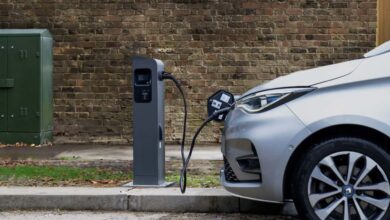The sound system is so good it gave me goosebumps

Being a journalist covering purely electric vehicles and a Model 3 owner, I acknowledge my own bias towards electric vehicles that are designed and built on EV specific platforms. Electric vehicles that share underpinnings with combustion powered versions are usually compromised in some way.
I wanted to challenge this bias by testing an EV from one of the most well known and established automakers. BMW has been making cars for nearly 100 years and has a reputation for producing high quality, luxury vehicles that are engaging to drive. Does the BMW i5 M60 live up to this reputation without too many compromises?
My i5 M60 test vehicle was fitted with the optional M Sport Plus Package bringing the total driveaway price to $240,174, easily the most expensive car I have tested so far. A similarly specified rear-wheel drive BMW i5 eDrive40 costs significantly less at $173,110. For those who want more space, an i5 M60 Touring wagon is also available.
The i5 is based on BMW’s Cluster Architecture (CLAR) that is used for a wide range of BMW vehicles. CLAR is designed to be flexible and supports all types of drivetrains from internal combustion engines, to hybrid and fully electric. BMW is developing a new version of their Cluster Architecture coming in 2025 that is geared more towards electric drivetrains.
Flexible vehicle architectures such as CLAR do have advantages over EV specific platforms as they allow legacy automakers like BMW to quickly produce fully electric variants across their model range. It also saves on platform development costs which can be significant investments, into the billions for entirely new platforms.
Compromised storage space
Addressing the key question first, the BMW i5 does have some compromises, mainly in terms of storage space. The bonnet on the i5 is long and should have tons of room underneath for a large front trunk (frunk). Instead there is nothing but the windscreen washer fluid spout and a big plastic cover hiding internal components underneath.
People might not use a frunk often, but when you need extra space for a road trip they are invaluable. Frunks are also useful places to store infrequently used charging cables, freeing up space in the boot. Some EVs like the Ford Mustang Mach-E include drainage holes in the frunk, making them an ideal place to throw wet or dirty gear you don’t want inside carpeted areas of the car.
Boot capacity of the i5 is 490 L which sounds decent on paper, but is hard to fully utilise due to its shallow height and sloping sides. The hinged underfloor area is big enough to store the charging cables that come with the car so you will need to find somewhere else to stash these or remove them if you want to make use of the extra space.
In comparison, the Tesla Model 3 is a much smaller car but has a total cargo storage area of 682 L including an 88 L frunk. The frunk on my Model 3 is well utilised on holidays and for picking up takeaway food. The underfloor area of the boot is big enough for charging cables, shopping bags and a picnic blanket which frees up the rest of the boot for other items.
The Lucid Air (not available in Australia) is a great example of what can be achieved with clever packaging in a luxury electric sedan similarly sized to the BMW i5. The Lucid Air boot alone holds 627 L, and it also has a huge frunk that can store another 283 L. In total this is 85 % more cargo space than the BMW i5.
Inside the i5 cabin, storage space for smaller items is limited. Many electric vehicles have cavernous centre consoles and open compartments between the front seats for storing large items. Instead, the i5 has two cupholders up front and just one single shallow storage area underneath the folding centre armrest.
Aside from storage space, legroom for rear seat passengers is impacted by the transmission tunnel hump, although this is mainly a problem when carrying three passengers in the back. Otherwise, rear seat passengers have plenty of space, comfortable heated seats and are well looked after with amenities such as individual climate zones on each side and 4x USB-C ports.
Almost every feature you can think of
To offset the compromises described above, the BMW i5 M60 includes an exhaustive standard feature list and endless ways to customise the vehicle. When purchasing a new car there are 10 no cost paint options plus BMW Individual Paintwork, 4 wheel options, 3 leather colours and 6 interior trim options.
The optional $2,462 Comfort Package adds front and rear seat heating and a heated steering wheel. For $3,077 the M Sport Plus Package adds various M styled elements such as seat belts and shadow lines to the exterior.
High levels of customisation in the BMW i5 extend to the infotainment screens, where you can control every aspect of the car. The infotainment screens are crisp looking and responsive. I also discovered that most functions had multiple ways to interact with them including BMW’s iDrive rotary dial, capacitive touch buttons, on-screen controls, voice activation and gesture control.
Capacitive touch buttons were hit and miss in my experience, especially the buttons within the ambient lighting strip surrounding the car because there is no feedback from them at all. Passengers using the volume control knob on the centre console would often mute audio or skip tracks accidentally as these buttons are too close to the volume knob.
Gesture control is a unique feature I have not seen in a vehicle before, which allows you to control the audio and respond to phone calls or notifications with a wave of your hand in front of the screen. For example, thumbing sideways skips backwards or forwards and moving your hand in a circle while pointing adjusts the volume up or down.
With all these different options at your fingertips, the infotainment system can be confusing at times. If you want to simplify things, wireless Apple CarPlay and Android Automotive are both available and look great on the large central touchscreen.
The usual caveat of phone battery drain applies, sadly the wireless charging pad was not fast enough to prevent my phone from draining itself.
My favourite interior feature was the 17 speaker Bowers & Wilkins sound system. It sounded so amazing I got goosebumps listening to my favourite songs. General comfort levels in the i5 were very high as you would expect from a luxury vehicle in this price range. Massaging seats is about the only missing feature that I have seen on competing luxury cars.
Driver assistance is very comprehensive in the BMW i5, including high resolution cameras and several features to enable autonomous parking and reversing. Adaptive cruise control and lane centering worked very well on the highway apart from a brief moment when it cut out for no reason.
The BMW i5 also includes practical options such as 750 kg unbraked towing capacity and 80 kg towball weight for all variants. Braked towing capacity is 1,500 kg for the rear-wheel drive eDrive 40 variant and increases to 2,000 kg for the all-wheel drive M60. Special slots next to the glass roof also allow roof racks to be fitted to the vehicle if necessary.
Driving experience
Pressing the Start / Stop button to fire up the BMW i5 is dramatic, a deep gong sound plays from the speakers and the steering wheel drops into place inviting you to take off. I liked how stopping the car is optional too. The car turns off automatically once you leave the driver’s seat, saving a needless button press.
Driving the BMW i5 M60 was a serene experience with effortless acceleration and light steering. One pedal driving is easy to select by pulling the gear lever back once for D mode and then again for B mode. Regenerative braking was well tuned, leaving the brake pedal rarely used.
The i5 does not come with the usual eco and normal driving modes found on most cars. Instead the i5 has My Modes with names like Expressive and Relax. These modes change the atmosphere of the car by adjusting ambient lighting, screens, climate control settings and opening or closing the panoramic glass roof shade to make it more relaxing.
Engaging Sport mode does increase the stiffness of the suspension and steering, although it disables traction control and all safety aids so I did not spend much time driving in Sport mode. There is also a boost paddle behind the steering wheel, pressing this helps to propel the car from 0-100 km/h in just 3.8 seconds.
With a staggered wheel setup featuring 275 mm wide Pirelli P Zero tyres on the back, the i5 M60 has no trouble utilising all of the power available from both motors. On twisty roads however, you start to feel the 2.3 tonne weight of the car around the corners. For example, the i5 did not feel as calm or confident around bends as the Kia EV6 GT I tested recently.
The i5 features rear-wheel steering or Integral Active Steering as BMW calls it, which can turn the rear wheels up to 3.5 degrees. Rear wheels turn in the opposite direction to improve turning circles at low speed or in the same direction as the front wheels at higher speeds for stability. The effect was most noticeable on tight roundabouts where it felt odd, like the car was sliding out.
Range and charging
Range on the i5 M60 dash showed 431 km at 99% state of charge when I picked up the car. On a 235 km return trip to the Blue Mountains it consumed 17.0 kWh / 100 km which is decent for a car this big and heavy. Over the entire week loan I averaged 19.5 kWh / 100 km, which equates to just over 400 km range on a full charge.
BMW supplies everything to make charging the i5 easy, providing both a mode 2 charger for standard powerpoints as well as a Type 2 to Type 2 cable for public charging. Five years of complimentary charging on the Chargefox network is also included. Maximum charging speeds are up to 22 kW AC and 205 kW DC, enabling a 10-80 % charge in 30 minutes.
Searching for EV charging stations is quick and easy using the built-in navigation, bringing up many more results than I have seen on other EVs. During navigation the car also shows useful information such as remaining state of charge upon arrival and can add charging stops if necessary.
Conclusion
Overall, I found the BMW i5 M60 was a very pleasant car to drive although not as engaging as I had anticipated. At 5 metres long, it felt big and awkward at times on suburban and city streets. The i5 felt most at home cruising along highways where you can relax and enjoy the sound system and luxurious interior.
As an electric vehicle, the i5 includes most of the major convenience features and fast charging capabilities to make it an easy car to live with. Vehicle to load (V2L) is one omission that more people are looking for these days and might expect to find on a car in this price range.
BMW’s choice to build electric vehicles on their CLAR platform does result in compromised storage and interior space compared to electric vehicles built on dedicated platforms. However, BMW has packed such a long list of features into the i5 that people looking at a luxury electric vehicle may be happy to live with such compromises.
Table of key specifications for the BMW i5 M60 xDrive:
| Variant | BMW i5 M60 xDrive | ||
| Starting price | $215,900, plus on-road costs | ||
| Paint colours and options | Too many to list here, see BMW website | ||
| Battery size | 84 kWh gross, 81 kWh usable | ||
| Battery chemistry | Nickel Manganese Cobalt (NMC) | ||
| Range | 516 km WLTP | ||
| Driven wheels | All-wheel drive | ||
| Power / Torque | 442 kW / 820 Nm | ||
| Charging speed | 22 kW DC, 205 kW AC | ||
| Charging socket | CCS2 combo | ||
| Exterior dimensions | Length: 5060 mm Width: 1900 mm Height: 1515 mm Wheelbase: 2995 mm Ground clearance: 136 mm |
||
| Kerb weight | 2305 kg | ||
| Storage space | Frunk: N/A Boot, rear seats up: 490 L |
||
| Service interval | Condition based | ||
Tim has 20 years experience in the IT industry including 14 years as a network engineer and site reliability engineer at Google Australia. He is an EV and renewable energy enthusiast who is most passionate about helping people understand and adopt these technologies.



